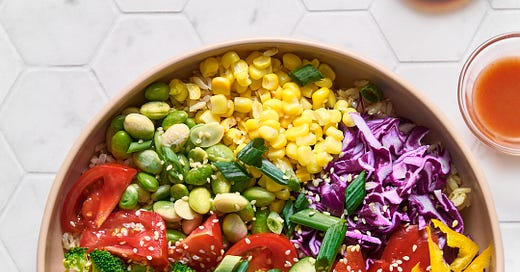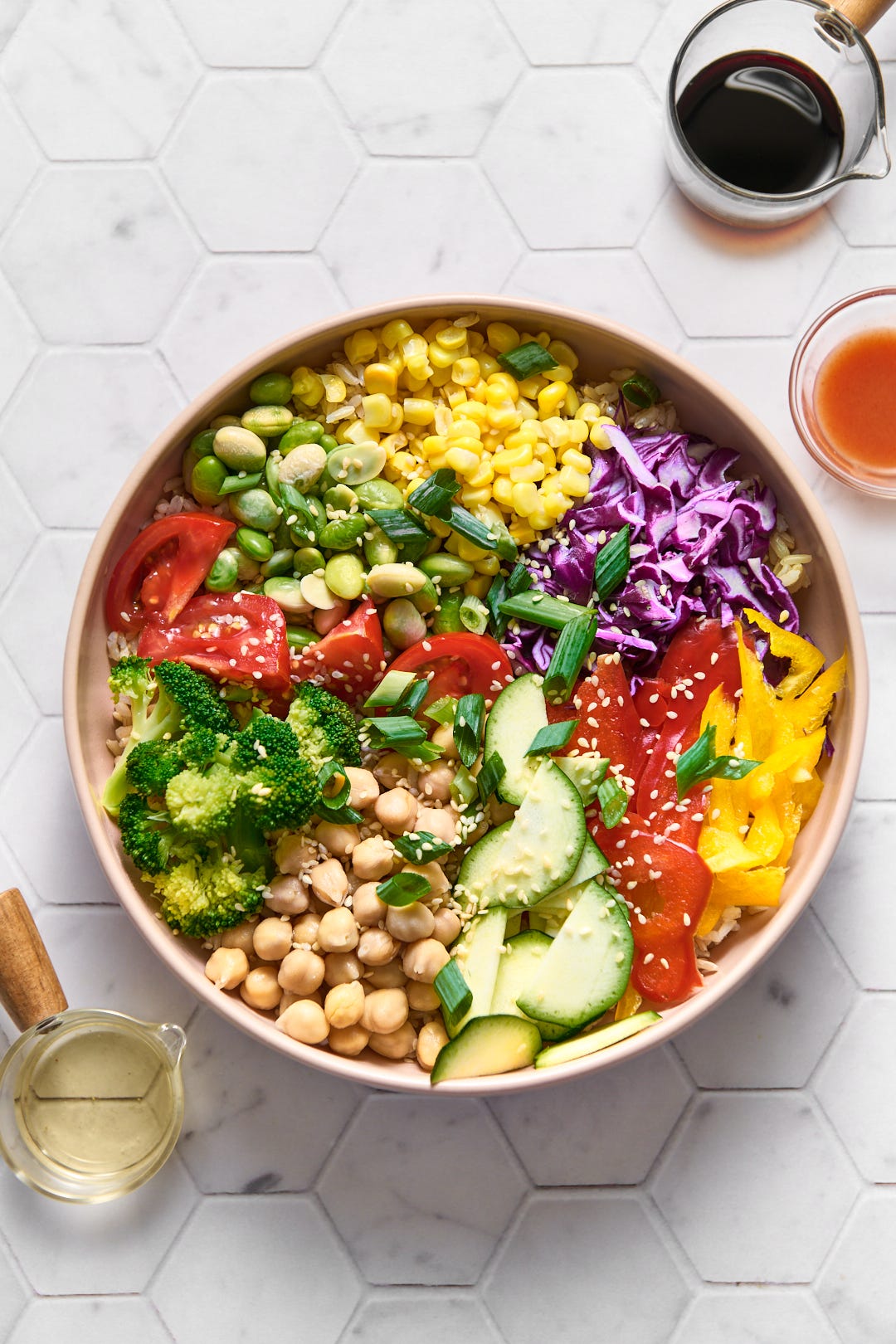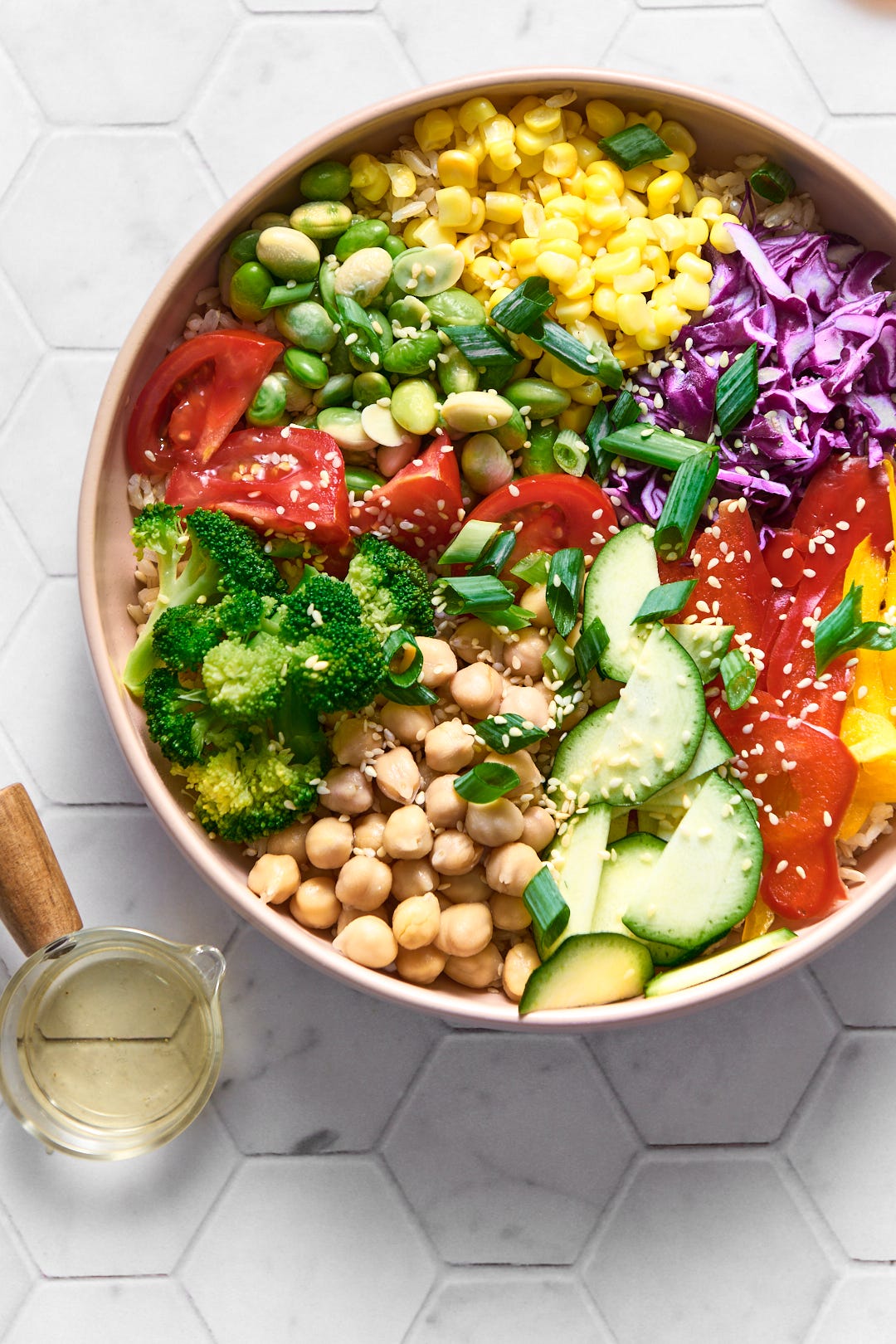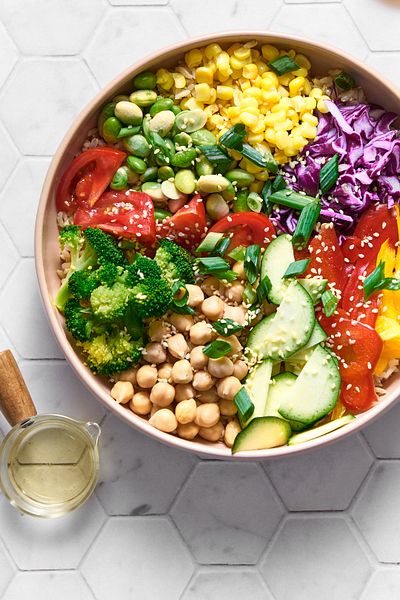Fresh, nutritious, and easy — we’ve become a bit obsessed with poke bowls lately. They’ve taken over our weekend and weeknight menus. I think they might just become your new go-to summer meal too!
If you've never had a poke bowl, let me give you a quick rundown.
A poke bowl is a traditional Hawaiian dish featuring raw fish. It has gained worldwide popularity due to its versatility, customizability, flavor, and health benefits! A plant-based version swaps out the fish for plant-based protein.
While there are no strict rules for preparing a poke bowl, most include the following components:
Components of a Poke Bowl
Base: The foundation of a poke bowl is usually a cooked grain like rice (white, brown, or sushi rice), but it can also include alternatives like quinoa, mixed greens, or noodles or a mixture of any of these. These can be served warm or at room temperature.
Protein: The main ingredient is typically raw, marinated fish. However, vegan options include tofu, edamame, tempeh, hummus, and/or any beans. You could also include quinoa in this category.
Vegetables: Fresh vegetables add crunch and color to the bowl. Common choices include cucumber, bell peppers, tomatoes, radish, seaweed salad, and shredded carrots. Cooked veggies can be included as well like blanched or lightly steamed broccoli, asparagus, cauliflower, or cooked sweet potato or pumpkin. The cooked veggies can be served warm or at room temperature (which is what I prefer).
Toppings: A variety of toppings provide additional flavor and texture. Popular toppings include avocado, sesame seeds, pumpkin seeds, cilantro, green onion, pickled ginger, nori (seaweed) strips.
Sauces: To finish, various sauces can be drizzled over the bowl. These can be prepared sauces like spicy mayo or simple condiments like soy sauce, shoyu, tamari, rice wine vinegar, or apple cider vinegar.
Here are some other important points about poke bowls.
Poke Bowl FYI
Buddha bowl meets salad: Poke bowls differ from Buddha or grain bowls because most poke bowl components are simple and lean toward the fresh and light side. In my opinion, a poke bowl is like a summer bowl whereas a Buddha bowl is warming with primarily cooked components. My version of a poke bowl is like a cross between a Buddha bowl and a salad.
Anatomy: The components of a poke bowl are layered on top of the whole grains.
Easy: A poke bowl should be a low-maintenance meal ideal for lunch or dinner. If you have the veggies and protein already chopped and prepped, it’s quick and easy. The same goes for the cooked grains, although I prefer to cook them right before plating and serve them warm.
Nutrition: Nutritionally speaking, a plant-based poke bowl offers complete nutrition including complex carbohydrates, protein, and healthy fats. Vibrant colors and a wide variety of phytonutrients are also key characteristics of a good poke bowl.
Sauce: Although I love a good sauce, I usually dress my poke bowl with shoyu, brown rice vinegar, and a vinegar-based hot sauce. I like to keep it simple, letting the whole food flavors shine through. You can add more dimension and flavor with a prepared whole-food sauce.
This poke bowl was inspired by the menu at my favorite poke bowl spot. I order from this spot often (multiple times a week!). Many poke bowl restaurants in our area use brown rice, fresh veggies, whole food proteins, and oil-free sauce — so grateful! So it’s an easy solution for weeknight dinners or when I don’t feel like cooking. As the temperature skyrockets in Taipei, this is happening a lot! And since I'm in Asia, my version of the poke bowl tends to feature Asian flavors and ingredients.
Bespoke Bowls!
I’ve kept this bowl very light, with minimal fat and plenty of crisp, crunchy veggies. However, you can pair your poke bowl with a rich, luscious sauce or sliced avocado for added heft and richness.
You can also include more cooked components or serve them hot to make your poke bowl cozier. All the suggested additions are simply that — suggestions. Customize your poke bowl with the whole foods you enjoy, and it’s bound to be delicious.
POKE BOWL TEMPLATE
The serving size varies and should cater to your hunger levels. The guide below is for 1 serving.
INGREDIENTS
Base (1 to 3 cups) One of or a combination of the following
Cooked brown rice
Cooked quinoa
Cooked whole grain noodles (brown rice, quinoa, whole wheat, buckwheat)
Any lettuce
Baby spinach
Protein (1 to 2 cups)
Cooked or raw tofu
Cooked tempeh
Frozen shelled edamame, thawed
Hummus
Chickpeas
Black beans
Veggies (1 to 3 cups)
Cucumber, thinly sliced
Carrots, shredded or ribbons
Tomatoes, chopped
Bell peppers, thinly sliced
Purple or green cabbage, thinly sliced
Radishes, thinly sliced
Zucchini, thinly sliced
Snow peas or snapped peas (raw or cooked)
Asparagus, chopped (raw or cooked)
Broccoli, small florets (raw or cooked)
Cauliflower, small florets (raw or cooked)
Sweet potato, chopped (cooked)
Pumpkin, chopped (cooked)
Frozen corn kernel (thawed)
Toppings
Green onion, sliced
Fresh cilantro
Sesame seeds, black or white
Pumpkin seeds
Peanuts, chopped
Avocado, sliced
Sauces and Condiments
Fresh lime or lemon juice
Shoyu or soy sauce or tamari
Apple cider vinegar
Brown rice vinegar
Umeboshi vinegar
Hot sauce
HOW-TO
First cook your grains or noodles according to directions. While cooking, prepare your other components.
When the rice is cooked (and still warm) layer 1 to 1½ cups of grains (or a mixture of grains and greens) to the bottom of your bowl.
Add the protein and all the veggies in sections on top of the grains/greens/noodles. Garnish with your chosen toppings and serving with a side of your chosen condiments and/or sauces.
Here’s what’s in my bowl — this reflects my weekly order from our local poke bowl restaurant. This is for a single serving.
1 cup cooked brown rice (warm)
¼ cup thawed, shelled edamame
¼ cup canned chickpeas, drained and rinsed
¼ cup thinly sliced yellow bell pepper
¼ cup thinly sliced red bell pepper
¼ cup thinly sliced zucchini
¼ cup thinly sliced purple cabbage
¼ cup chopped tomatoes
¼ cup blanched broccoli florets (cooled to room temp)
¼ cup thawed corn kernels
2 teaspoons sesame seeds
1 green onion, thinly sliced
Shoyu (for drizzling)
Brown rice vinegar (for drizzling)
Hot sauce (for drizzling)
Printable Recipe
Questions
What’s shoyu? Shoyu is Japanese soy sauce. It’s made from fermented soybeans, wheat, salt, and water and is the preferred soy sauce in many professional kitchens. If soy and wheat are in your diet, try it! Eden brand is my favorite.
What’s umemboshi vinegar? Umeboshi vinegar, also known as ume plum vinegar, is a tangy, salty, and slightly fruity vinegar made from the brine of pickled umeboshi plums. I buy it online and at health food stores. It’s said that umeboshi can help with digestion, offers antioxidants, and has an alkalizing effect on the body. I love the taste! Eden brand is my favorite.








